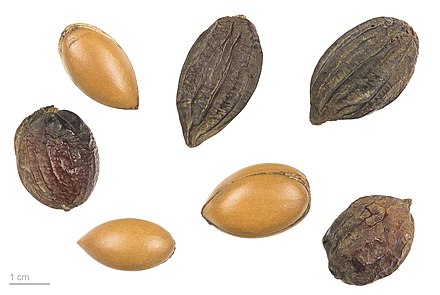Argania
Argania (Tashelhit: ⴰⵔⴳⴰⵏ Argan) is a genus of flowering plants containing the sole species Argania spinosa, known as argan, a tree endemic to the calcareous semidesert Sous valley of southwestern Morocco[3] and to the region of Tindouf in southwestern Algeria.[4][5] Argan trees grow to 8–10 m (26–33 ft) high and live up to approximately 200 years. They are thorny, with gnarled trunks and wide spreading crown. The crown has a circumference of about 70 m (230 ft) and the branches lean towards the ground.
The leaves are small, 2–4 cm (0.79–1.57 in) long, and oval with a rounded apex. The flowers are small, with five pale yellow-green petals; flowering in April. The fruit is 2–4 cm (0.79–1.57 in) long and 1.5–3 cm (0.59–1.18 in) broad, with a thick, bitter peel surrounding a sweet-smelling but unpleasantly flavored layer of pulpy pericarp. This surrounds the very hard nut, which contains one (occasionally two or three) small, oil-rich seeds. The fruit takes over a year to mature, ripening in June to July of the following year.
The scientific name Argania is derived from argan, the name of the tree in Shilha, the Berber language which is spoken by the majority of the people living in the areas where the tree is endemic. Shilha Berber has a rich vocabulary for the various parts of the fruit, its stages of ripeness, and its harvesting and processing. The oil is also called argan. In medieval Arabic pharmacological sources, the tree is known as harjān, a distortion of the Berber word argan.
On March 3, 2021, the United Nations General Assembly adopted a resolution to proclaim May 10th the International Day of Argania, an observance to be celebrated annually.[6] Amongst the motivations for this proclamation were the importance of Argania to sustainable development in areas where it is endemic. The UN resolution was submitted by Morocco, and was co-sponsored by 113 member states of the United Nations before being adopted by consensus.[7]
In Morocco, arganeraie forests now only cover some 8,280 km2 (3,200 sq mi) and are designated as a UNESCO biosphere reserve. Their area has shrunk by about half during the last 100 years, due to charcoal making, grazing, and increasingly intensive cultivation. The best hope for the conservation of the trees may lie in the recent development of a thriving export market for argan oil as a high-value product. However, the wealth brought by argan oil export has also created threats to argan trees in the form of increased goat population. Locals use the newfound wealth to buy more goats and the goats stunt the growth of the argan trees by climbing up and eating their leaves and fruit.[8] It is reported that the display of the tree climbing goats is staged or faked in areas popular with tourists, as the goats only very infrequently climb the trees without human intervention.[9][10]
In some parts of Morocco, argan takes the place of the olive as a source of forage, oil, timber, and fuel in Berber society.
_tree_in_Morocco.jpg/440px-Goats_on_an_Argan_(Argania_spinosa)_tree_in_Morocco.jpg)


